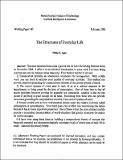The Structures of Everyday Life
Author(s)
Agre, Philip E.
DownloadMain article (1.246Mb)
Metadata
Show full item recordAbstract
This note descends from a talk I gave at the AI Lab's Revolving Seminar series in November 1984. I offer it as an informal introduction to some work I've been doing over the last year on common sense reasoning. Four themes wander in and out.
1) Computation provides an observation vocabulary for introspection. With a little work, you can learn to exhume your models of everyday activities. This method can provide empirical grounding for computational theories of the central systems of mind.
2) The central systems of mind arise in each of us as a rational response to the impediments to living posed by the laws of computation. One of these laws is that all search problems (theorem proving for example) are intractable. Another is that no one model of anything is good enough for all tasks. Reasoning from these laws can provide theoretical grounding for computational theories of the central systems of mind.
3) Mental models tend to form mathematical lattices under the relation variously called subsumption or generalization. Your mind puts a lot of effort into maintaining this lattice because it has so many important properties. One of these is that the more abstract models provide a normalized decomposition of world-situations that greatly constrains the search for useful analogies.
4) I have been using these ideas in building a computational theory of routines, the frequency repeated and phenomenologically automatic rituals of which most of daily life is made. I describe this theory briefly.
Date issued
1985-02Publisher
MIT Artificial Intelligence Laboratory
Series/Report no.
MIT Artificial Intelligence Laboratory Working Papers, WP-267